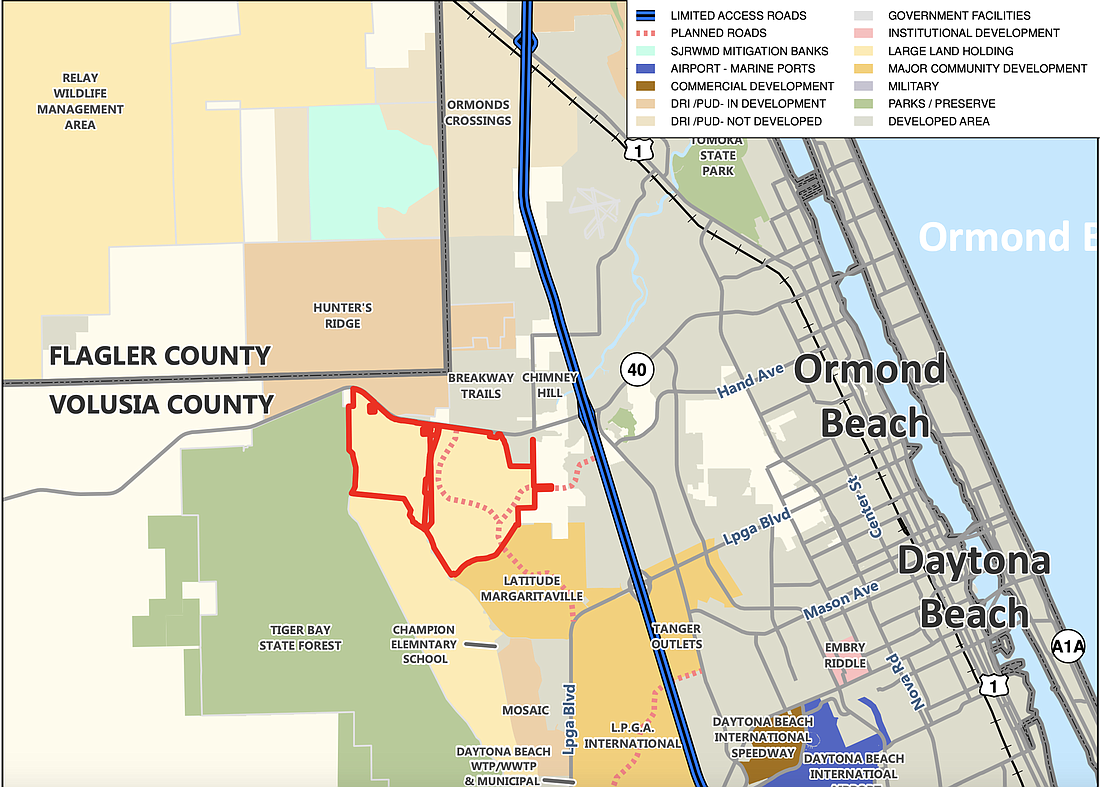- December 13, 2025

Though Avalon Park Daytona has yet to break ground, the city of Ormond Beach is bracing itself for the impacts of the massive development, which could build up to 10,000 homes by 2045, by working on its relationship with the city of Daytona Beach as well as planning for infrastructure needs.
"We know, no matter what the pace of Avalon Park’s buildout is, it will have a critical effect on our Ormond Beach community," said Joyce Shanahan, Ormond Beach city manager during a City Commission workshop on western development transportation issues, held on Tuesday, Oct. 19.
Avalon Park has scaled back its development order, and the developer plans to build a total of 3,250 homes, along with 200,000 square feet of commercial development, by 2030. This will be split into two phases — phase 1A and 1B — focused on the land formerly owned by Minto Communities.
Shanahan informed the commissioners that she has had regular correspondence with new Daytona Beach City Manager Deric Feacher, and both of them agree that their staff should update each other on the development's progress. Due to a 2006 comprehensive settlement agreement with Daytona Beach, Ormond Beach will be the water and sewer provider for the residents of Avalon Park. Utilities will be sold to Daytona Beach at a wholesale price, and Daytona will resell the utilities forward to Avalon Park at a retail price.
The Avalon Park Group development was previously scheduled to break ground earlier this year, but now that has been pushed back to sometime in 2022. Additionally, in November, Ormond Beach will start a series of citizen workshops, modeled after the OB Life workshops in 2018.
The meetings held with Daytona Beach staff are a step forward, said Shawn Finley, Ormond Beach Public Works director.
"We are going to get a lot further by working together than having an adversarial relationship," Finley said. "And so I think the start of these meetings, the start of this relationship, is going to be something that is going to be necessary for the next decade and the next decade after that."
The city has also worked with Volusia County on a recently completed transportation impact methodology, explained Shanahan. Particularly, the city weighed in on how internal capture rates are calculated, and as a result, Volusia County reduced Avalon Park's initial estimate claiming 40% internal capture to less than 10%.
"I believe this will hold Avalon more accountable to paying their fair share of road impacts in our community," Shanahan said.
The city is also working with the River to Sea Transportation Planning Organization and the Florida Department of Transportation to address future infrastructure impacts.
Matt Wiesenfeld, of HDR, the engineering firm aiding the city in navigating the future impacts of Avalon Park, gave the commissioners at the workshop an overview of where the development stands. Currently, phases 1A and and 1B do not include a Tymber Creek Road extension, but do rely on Hand Avenue as a prominent corridor to run through the property. The plans propose connections to Breakaway Trail and LPGA Boulevard, and traffic is estimated to be split about evenly between the two roads.
HDR estimates that, after the completion of phases 1A and 1B, the development's daily trip generation will be 34,644 trips, with about 3,406 of those trips happening at evening peak hours. However, should Avalon Park achieve its complete buildout of 10,000 homes and 1 million square feet of commercial development — which Finley estimated would be twice the size of The Pavilion in Port Orange — the number of daily trips generated would increase by over 260% to total 127,382, with 11,884 trips generated during evening peak hours.
The key to mitigating the effects of Avalon Park is negotiation, said Maryam Ghyabi, CEO of Ghyabi Consulting and Management. Avalon Park Daytona is planned to be double the size of Avalon Park Orlando, she said.
"This project is all about making a deal because there's no rules that govern it," Ghyabi said. "... It has a lot of pieces to it and we have to make sure that we don't miss anything."
The Ormond Beach City Commissioners all expressed alarm at the size of the development, and said more residents should be aware of what will be built on the other side of its western city limit. It's a position the city was placed in due to decisions made by past commissioners, Commissioner Dwight Selby said.
“This is going to totally change what it means to live in Ormond Beach," Selby said.
In the early 2000s, the land was owned by Consolidated-Tomoka Land Co., whose owners wanted the city to relax its wetland standards to develop the 3,000 acre-land. The commission refused, and the owners turned to neighboring Daytona Beach. After a dispute in court between the two cities, the land was eventually annexed into Daytona.
"That's what happens when you don't negotiate and you can't reach a reasonable deal," Mayor Bill Partington said. "You end up with something that was far worse than anything could have ever imagined."